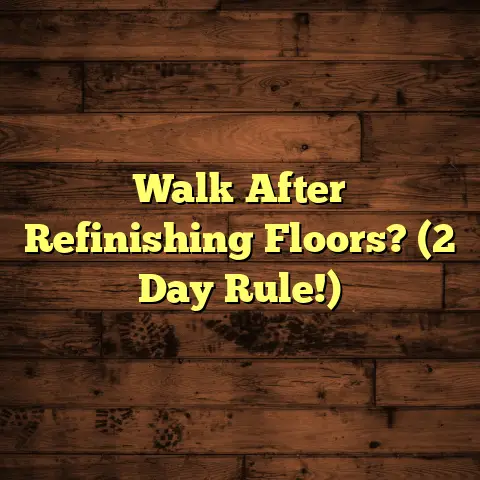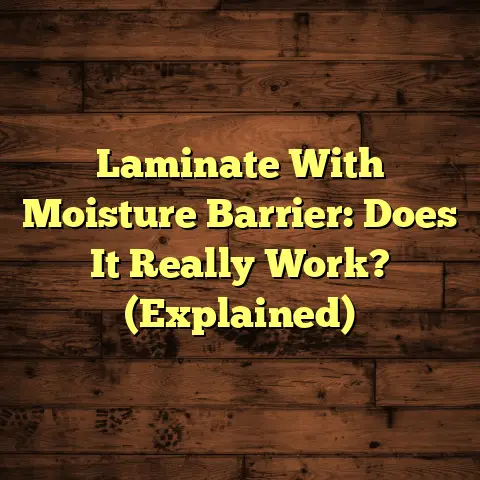Fill Voids Under Concrete? (1 Call Could Save Slab!)
(Insert striking image here: a cracked, uneven concrete slab contrasted with a smooth, well-maintained one.)
Ever see a concrete slab looking like it’s seen better days? Cracks spiderwebbing across it, uneven surfaces that trip you up?
Chances are, there’s something going on underneath that slab – voids.
These hidden gaps can cause serious problems, leading to costly repairs and even safety hazards.
But here’s the good news: often, a simple call to a professional can prevent further damage and potentially save the entire slab.
Trust me, I’ve seen it happen countless times in my years as a flooring contractor. Let’s dive in!
Section 1: Understanding Voids
Under Concrete
Voids under concrete are like invisible enemies, slowly undermining the stability of your structure.
Definition of Voids
So, what exactly are voids? Simply put, they’re empty spaces that form beneath concrete slabs.
Think of it like this: the concrete is the stage, and the soil beneath is the support crew.
If the support crew starts disappearing, the stage (your concrete slab) is going to suffer.
These voids can range in size from small pockets to large cavities, depending on the cause and severity.
How do they form? Several factors contribute, including:
-
Soil Erosion: Water runoff, leaks, and poor drainage can wash away soil particles over time, creating empty spaces.
-
Moisture Intrusion: Excessive moisture can saturate the soil, causing it to expand and contract.
This constant movement can weaken the soil’s structure and lead to voids.
-
Poor Compaction: If the soil wasn’t properly compacted during the initial construction, it’s more susceptible to settling and erosion.
Common Causes
Let’s break down the primary culprits behind void formation:
-
Natural Settling: Over time, soil naturally compacts and settles, especially in areas with loose or unstable soil.
This is just the earth doing its thing, but it can leave gaps under your concrete.
-
Tree Root Growth: Tree roots can be surprisingly destructive. As they grow, they can displace soil and create voids.
Plus, when a tree is removed, the decomposing roots leave behind empty channels.
-
Water Drainage Issues: Improper drainage is a major void creator. Gutters that dump water too close to the foundation, leaking pipes, and poor grading can all contribute.
This constant water flow erodes the soil and weakens its support.
-
Construction-Related Factors: Sometimes, the problem starts during construction. Inadequate soil compaction, improper backfilling, or the use of unsuitable fill materials can all lead to voids down the road.
I’ve seen cases where builders cut corners, and it always comes back to haunt the homeowner later.
Section 2: Signs and Symptoms of Voids
Knowing what to look for is half the battle. Here are some telltale signs that you might have voids under your concrete:
Visual Indicators
Keep an eye out for these physical signs:
-
Cracks in the Slab: Cracks are often the first and most obvious sign. They can range from hairline fractures to wide, gaping fissures.
Pay attention to the direction and pattern of the cracks, as this can provide clues about the underlying cause.
-
Uneven Surfaces: Is one section of the slab noticeably higher or lower than the surrounding areas?
This is a classic sign of settling and void formation. Grab a level and check different spots on the slab.
-
Sagging: Sagging is similar to unevenness, but it’s more gradual and widespread.
You might notice a gentle slope or depression in the slab.
-
Sinking: Sinking is when the slab is below the level it should be.
Functional Impacts
Voids don’t just affect the appearance of your concrete; they can also impact the functionality of your spaces:
-
Tripping Hazards: Uneven surfaces and cracks create obvious tripping hazards, especially for children and the elderly.
I’ve seen some nasty falls caused by seemingly minor cracks.
-
Damage to Flooring Materials: If you have flooring installed over the concrete slab (tile, hardwood, carpet), voids can cause it to crack, buckle, or become uneven.
This can lead to costly repairs or replacements.
-
Impact on Plumbing or Electrical Systems: In some cases, voids can affect underground plumbing or electrical conduits.
Settling can put stress on pipes, leading to leaks or breaks.
It can also damage electrical wiring, creating a fire hazard.
Section 3: The Risks of Ignoring Voids
Ignoring voids under concrete is like ignoring a toothache. It might not seem like a big deal at first, but it will only get worse over time.
Structural Integrity
Here’s what you risk when you neglect those hidden gaps:
-
Compromised Structural Integrity: Voids weaken the support system for your concrete slab, making it more vulnerable to cracking, settling, and even collapse.
This is especially concerning for foundations, driveways, and patios.
-
Increased Cracking and Settling: As voids grow, the concrete slab becomes increasingly unstable.
This leads to more cracking, more settling, and a greater risk of serious damage.
-
Potential for Collapse: In extreme cases, ignoring voids can lead to partial or complete collapse of the concrete slab.
This is a serious safety hazard, especially for structures that support heavy loads.
Financial Implications
Procrastination can be costly:
-
Increased Repair Bills: The longer you wait, the more extensive and expensive the repairs will be.
Small voids can be filled relatively easily, but large voids may require more complex and costly solutions.
-
Loss of Property Value: Damaged concrete can significantly reduce your property value.
Cracks, uneven surfaces, and sagging are all red flags for potential buyers.
-
Potential Legal Issues: If someone is injured due to a void-related hazard on your property, you could be held liable.
This could result in costly lawsuits and settlements.
Section 4: The Process of Filling Voids
Okay, so you suspect you have voids. What’s the next step? Here’s what the process of filling voids typically looks like:
Assessment
First, a professional will need to assess the extent of the problem:
-
Professional Evaluation: A qualified contractor will inspect the concrete slab and surrounding area to identify the location and size of the voids.
They’ll also look for signs of underlying issues, such as drainage problems or soil instability.
-
Specialized Tools: Contractors may use specialized tools, such as ground-penetrating radar (GPR), to detect voids that aren’t visible from the surface.
GPR can provide a detailed image of the subsurface, allowing them to accurately map the voids.
Filling Techniques
Once the voids have been identified, there are several methods for filling them:
-
Polyurethane Injection: This is a popular and effective method for filling voids under concrete slabs.
A polyurethane foam is injected into the void through small holes drilled in the concrete.
The foam expands to fill the void, stabilizing the slab and preventing further settling.
Advantages:
- Lightweight and doesn’t add significant weight to the soil.
- Fast curing time, allowing for quick repairs.
- Can be used in a variety of soil conditions.
- Environmentally friendly options are available.
Applicable Scenarios:
- Driveways
- Sidewalks
- Patios
- Garage floors
- Interior slabs
-
Mudjacking: Mudjacking is a traditional technique that involves pumping a mixture of mud, cement, and water under the concrete slab to lift it back into place.
Holes are drilled through the concrete, and the mud mixture is injected under pressure.
Process:
- Drill holes through the concrete slab.
- Pump a mud mixture under the slab.
- Lift the slab back to its original position.
- Patch the holes.
When It’s Used:
- Raising sunken concrete slabs.
- Stabilizing slabs with large voids.
- Correcting drainage problems.
-
Other Methods:
-
Foam Injection: Similar to polyurethane injection, but uses a different type of foam.
-
Concrete Replacement: In severe cases, the concrete slab may need to be completely replaced.
-
Section 5: Benefits of Professional
Intervention
Why not just try to DIY the void filling? Here’s why hiring a professional is almost always the best option:
Expertise
Professionals bring a wealth of knowledge and experience to the table:
-
Expertise: Professionals have the training and experience to accurately assess the problem, choose the right solution, and perform the work safely and effectively.
-
Specialized Equipment: They have access to specialized equipment, such as GPR, injection pumps, and lifting jacks, that are necessary for proper void filling.
-
Knowledge of Local Soil Conditions: Professionals are familiar with local soil conditions and can tailor their approach to the specific challenges of your area.
Long-term Solutions
Professionals don’t just offer quick fixes; they provide long-term solutions:
-
Long-term Solutions: Professionals address the underlying causes of void formation, preventing the problem from recurring.
-
Warranty: Many professionals offer warranties on their work, providing you with peace of mind.
-
Proper Compaction: They’ll ensure the soil is properly compacted, creating a stable base for your concrete slab.
Section 6: Case Studies
Let’s look at some real-life examples of how void filling can save the day:
(Insert before-and-after images here: examples of properties with void issues and the successful outcomes after intervention.)
-
Case Study 1: The Sunken Driveway
A homeowner noticed that their driveway was sinking near the garage. Cracks were appearing, and it was becoming difficult to park their car.
A professional contractor assessed the situation and determined that voids had formed due to poor drainage.
They used polyurethane injection to fill the voids, lifting the driveway back to its original level.
The homeowner was thrilled with the results, saying, “I was worried I’d have to replace the entire driveway, but they saved it! It looks like new.”
-
Case Study 2: The Cracked Patio
A family’s patio was riddled with cracks, making it unsafe for their children to play on.
They called a contractor who identified voids caused by tree root growth.
The contractor removed the dead tree roots and used mudjacking to fill the voids and stabilize the patio.
The family was relieved to have a safe and beautiful outdoor space again.
-
Case Study 3: The Unstable Foundation
A homeowner noticed cracks in their foundation walls and a sinking floor inside the house.
A structural engineer determined that voids under the foundation were compromising the structural integrity of the home.
The contractor used a combination of polyurethane injection and soil stabilization techniques to fill the voids and reinforce the foundation.
The homeowner was grateful that they caught the problem before it became catastrophic.
Lessons Learned
These case studies highlight the importance of addressing voids promptly.
Early intervention can prevent further damage, save money, and ensure the safety of your property.
Don’t ignore the warning signs!
Section 7: The Importance of Regular
Maintenance
Prevention is always better than cure. Here’s how to keep voids at bay:
Preventative Measures
-
Regular Inspections: Inspect your concrete slabs regularly for cracks, uneven surfaces, and other signs of damage.
-
Proper Drainage: Ensure that your gutters and downspouts are functioning properly and directing water away from the foundation.
-
Soil Stabilization: If you have unstable soil, consider soil stabilization techniques, such as compaction or chemical treatments.
Homeowner Responsibilities
-
Monitor for Changes: Pay attention to any changes in your concrete slabs, such as new cracks or increased settling.
-
Address Drainage Issues: Fix any leaks or drainage problems promptly.
-
Call in Professionals: If you suspect you have voids, don’t hesitate to call a professional for an evaluation.
Conclusion
Voids under concrete can be a silent threat to your property, but they don’t have to be.
By understanding the causes, recognizing the signs, and taking prompt action, you can protect your investment and ensure the safety of your home.
The peace of mind that comes with knowing your slab is secure is priceless.
So, take a walk around your property today. Assess your concrete slabs.
If you see anything suspicious, don’t wait. Give a professional a call.
That one call could save your slab!





